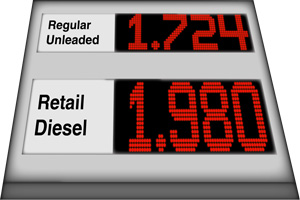Diesel Falls to Below $2 a Gallon

The average diesel retail price fell 2.8 cents last week to $1.980 a gallon, the lowest price since Jan. 24, 2005, when it was $1.959.
Diesel has declined a total of 50.2 cents over the past 14 weeks.
It moved below last week’s price of $2.008, the previous record for ultra-low-sulfur diesel since the United States switched to the use of ULSD nearly a decade ago, the Department of Energy reported after its Feb. 15 survey of fueling stations.
Trucking's main fuel also is 88.5 cents a gallon cheaper than a year earlier when the price was $2.865.
DOE also reported the average retail price of gasoline fell to $1.724 a gallon, down 3.5 cents from the previous week. Gasoline is 55 cents cheaper than it was a year ago when the price was $2.274.
It fell in all regions except the Midwest, where it rose four-tenths of a cent to $1.522.
“Low crude oil [prices], tons of supply of diesel, not a very cold winter, all of that is just overwhelmingly pushing diesel prices down and it has been for the last 16 months, really,” Energy Information Administration analyst Sean Hill told Transport Topics.
On Feb. 16, crude oil futures barely remained below $30 and closed on the New York Mercantile Exchange at $29.98, up $2.04 from $27.94 the week before.
Bloomberg News said volatile oil prices are a sign that crude doesn’t have much further to fall, according to Goldman Sachs Group Inc.
The oil market is “trendless” with increasing swings between $20 and $40 a barrel, analysts including Jeffrey Currie said in a note dated Feb. 15, Bloomberg said. Still, spikes that may drag prices to the “teens” won’t be a surprise because significant volatility is widely predicted, according to the bank.
Goldman’s Currie earlier in February predicted that oil could drop below $20 a barrel as the search for a level that brings supply and demand back into balance makes prices even more volatile, Bloomberg said. He also said that crude will swing between $20 and $40 a barrel over the next six to nine months as the rebalancing process plays out.




